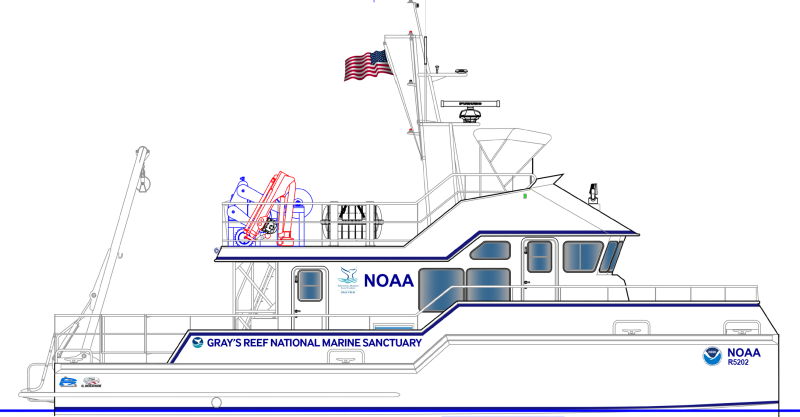All American Marine (AAM) has been awarded a contract to build another research vessel for the National Oceanic and Atmospheric Administration (NOAA), for NOAA's Gray’s Reef National Marine Sanctuary (GRNMS). GRNMS is located 19 miles off Sapelo Island, Ga., and is one of 14 marine sanctuaries and monuments that make up the U.S. National Marine Sanctuary System.
The research vessel will be constructed inside AAM’s facility on Bellingham Bay. The vessel will be a 52’x19’ semi-displacement aluminum catamaran hull that was developed by Nic de Waal of Teknicraft Design in Auckland, New Zealand.
The vessel is based on the proven design elements found in the recently commissioned and successful research vessel Storm Petrel built for NOAA’s Olympic Coast National Marine Sanctuary.
The new research vessel will be constructed to USCG standards for service in waters where the range to refuge is 150 nautical miles or less and will operate as a multipurpose research vessel along East Coast waters and offshore on ocean routes for up to 16 passengers and two crew.
The twin-engine speed and fuel-efficiency of this vessel will be fundamental to meet NOAA’s research goals and allow them to access and study this critical shoreline and marine area in the Southeastern U.S. The knowledge gained from science missions on this vessel will directly support the management and conservation of the marine sanctuary’s resources.
Gray's Reef National Marine Sanctuary is currently the only protected natural reef area on the continental shelf off the Georgia coast and one of only a few natural marine protected areas in the ocean between Cape Hatteras, N.C., and Cape Canaveral, Fla.
The approximately 22 square mile sanctuary (about 14,000 acres) of Gray's Reef is just a small part of the U.S. territorial Atlantic Ocean, yet its value as a natural marine habitat is recognized nationally and internationally.
“This larger vessel with greater range and deck space will transform scientific research and long-term monitoring capabilities at Gray’s Reef National Marine Sanctuary and across the South Atlantic Bight by providing an extremely capable, multi-mission platform for NOAA and our partners,” Stan Rogers, sanctuary superintendent, said in a prepared statement announcing the new contract. “This new vessel will help achieve NOAA’s mission including mapping, characterizing, and assessing the health of marine habitats in an ever changing environment.”
The semi-displacement catamaran hull design integrates a Teknicraft hull shape and is complemented by Teknicraft’s signature integration of a wave piercer that is positioned between the catamaran sponsons to break up wave action and ensure reduced drag while conducting research missions.
For the operator, one of the most valuable features of this vessel is the fuel economy. Powered by twin Cummins QSC8.3 engines with twin propellers, the custom vessel will serve as a asset for NOAA’s specific mission off coastal Georgia. The vessel will host a variety of research missions and visiting scientists concentrating on seafloor mapping, habitat characterization, data collection, and the monitoring of the health of ocean species and marine wildlife.
Onboard the vessel there is approximately 250 sq. ft. of working space on the aft deck, with a complete complement of working gear and a grid of deck sockets. The deck sockets are spaced every two feet and allow equipment and gear to be secured, moved, or removed from the working deck.
There will be a fly bridge with bimini top covering on the upper deck, allowing vessel operations from a higher elevation while conducting research missions. The top deck also features an Interocean Conduction wire winch, hauling winch and a Morgan 300.4 crane. The main deck features an adjustable A-Frame for launching scientific equipment.
Additional features of the research vessel include both a wet laboratory for examining specimens and a dry laboratory for processing data. On board the vessel’s main deck will be a fully equipped galley and comfortable dinette with settee/bunk, kitchenette, and wet head.
AAM has a proven track record with NOAA, having constructed a number of previous, highly successful vessels such as the Storm Petrel, Auk, Shearwater, Fulmar and Manta.




